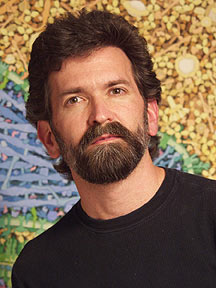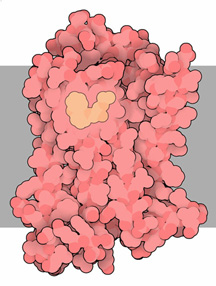

A Sight to Behold
By Mika Ono and Joseph Blumberg
If seeing is indeed believing, then there's nothing like an image to make the world of molecular biology come alive. That's the idea behind the illustrations created by David Goodsell, associate professor of Molecular Biology at The Scripps Research Institute, to get students excited about biology.
Goodsell, an artistic scientist or scientific artist if you prefer, recently reached a milestone in this endeavor. In April, Goodsell published his 100th "Molecule of the Month" on the Protein Data Bank website, part of the Research Collaboratory for Structural Bioinformatics.
"David Goodsell's masterful images contribute immensely not only to the visual impact of our website but also [to] our ability to communicate our work to a broader audience," notes Rutgers University Professor Helen Berman, the Protein Data Bank's director.
All of the molecules Goodsell features in the series are catalogued in the Protein Data Bank, which offers online access to an archive of the structures of nearly 50,000 proteins and other macromolecules in an ever-growing inventory.
Sparking Enthusiasm for Sciencee
Goodsell first started the Molecule of the Month project in 2000 with a grant from the National Science Foundation to create computer graphics methods for biomolecular education, which resulted in a program called BioEditor (see http://bioeditor.sdsc.edu). He created the first articles to test the new software. After the grant was over, Goodsell continued as a consultant with the Protein Data Bank to author the monthly column.
The Molecule of the Month series has acted as a resource for students and teachers around the world, and feedback has been overwhelmingly positive.
Scripps Research scientist Hua "Holly" Jing, for one, enthuses about the series and how it played a key role in her presentation at the recent San Diego Expanding Your Horizons conference, which encourages young girls who might be interested in science or math as a career.
"I had to tear the girls away from the computers, they were so attracted by the molecules in 3-D," says Jing, a senior research associate in the Ruggeri lab whose workshop focused on three-dimensional structures of biomolecules. "They loved Molecule of the Month images—with all their beauty and simplicity—as well as manipulating the molecules on the Protein Data Bank website."
The other hit with the kids, Jing reports, was the three-dimensional models from Goodsell's colleagues in Scripps Research Professor Art Olson's Molecular Graphics Laboratory. These colorful models can be examined in depth, giving people a concrete and direct sense of a molecule's structure and sparking insights into their role in biology.
The girls took a quiz at the end of the workshop, confirming that the visual and interactive tools had imparted a firm grasp of the key concepts of structural biology.
The Big 100
Goodsell's 100th Molecule of the Month shines the spotlight on adrenergic receptors, which, as Goodsell explains in the column accompanying his illustration, respond to the hormone adrenaline in times of danger or excitement, and prompts the body to mobilize resources for a "fight or flight" response.
"I generally choose a molecule whose importance is easy to understand," says Goodsell, "and that has an interesting story to tell."
Adrenergic receptors certainly live up to this billing. As part of a large class of similar proteins collectively known as G-protein-coupled receptors, they play diverse and important roles in human health. By some estimates, the human genome contains almost a thousand different types, including hundreds of receptors for taste and smell. Many widely used drugs, such as Claritin, act by binding to these receptors.
Goodsell notes that the structures of many of the molecules he features were determined by Scripps Research scientists. Of two similar molecules he describes in this month's column, one was solved recently by Scripps Research Professor Ray Stevens, Stanford researcher Brian Kobilka, and colleagues (see http://www.sciencemag.org/cgi/content/abstract/1150609 and http://www.sciencemag.org/cgi/content/abstract/1150577). The determination of this structure took 15 years of work, including the development of some of the first high throughput structural biology tools that Stevens pioneered with Scripps Research colleagues including Peter Schultz, Ian Wilson, Peter Kuhn, and Kurt Wüthrich.
Goodsell's scientific work in the Scripps Research Molecular Graphics Laboratory emphasizes discovery, but also integrates a visual approach. Computer graphics and simulation help the team investigate structure-function relationships in key biological systems. Current projects include developing a hierarchical model of HIV-1 drug therapy for evaluating new inhibitors and treatment strategies that address the problem of drug resistance. The group is also working on a recognition template method for prediction of function in new, functionally uncharacterized proteins.
The lab's education and outreach component includes not only Olson's three-dimensional molecular models, but also some advanced visual interfaces that enable an individual holding a molecular model to see an image of it on the computer screen, tumbling and turning in real time as he or she manipulates it. In addition to the Molecule of the Month series, Goodsell contributes an educational series for physicians to the journal The Oncologist. The column, "Molecular Perspective," includes some of his images.
Images of Wonder
To create his images, Goodsell uses a combination of hand-drawn and computer graphics illustrations, revealing a world that usually remains invisible to us. Surprisingly evocative, the renderings harken back to more familiar objects from balls to ropes to bowties.
Goodsell has taken a few art classes over the years, but his formal training is in science, with a Ph.D. from the University of California, Los Angeles. "My grandfather, who was a watercolorist, started me painting when I was a small child, and I learned most of what I know from watching him," says Goodsell, who has published several books of molecular illustrations, including The Machinery of Life (Springer-Verlag, 1993; second edition scheduled for 2008), Our Molecular Nature: The Body's Motors, Machines and Messages (Springer-Verlag, 1996), and Bionanotechnology: Lessons from Nature (J Wiley and Sons, 2004).
In his visual representations, Goodsell brings together artistic talent with his scientific expertise, creating images of molecular biology that capture his excitement about science and communicate it to others.
"The combination of art and science gives me a way to access the wonder of nature. It makes me really look at results and think about them in a deeper way," Goodsell says. "The thing that drives me continually is the beauty of these objects that I'm working on. [I'm] amazed at how unusual they are."
For more information on Goodsell's work, see his website at http://mgl.scripps.edu/people/goodsell. To visit the Protein Data Bank's Molecule of the Month column, see http://www.pdb.org/pdb/static.do?p=education_discussion/molecule_of_the_month/current_month.html.
Send comments to: mikaono[at]scripps.edu

"The combination of art and science gives me a way to access the wonder of nature," says David Goodsell of the Scripps Research Molecular Graphics Laboratory. "It makes me really look at results and think about them in a deeper way."

Goodsell's 100th Molecule of the Month shines the spotlight on adrenergic receptors.
